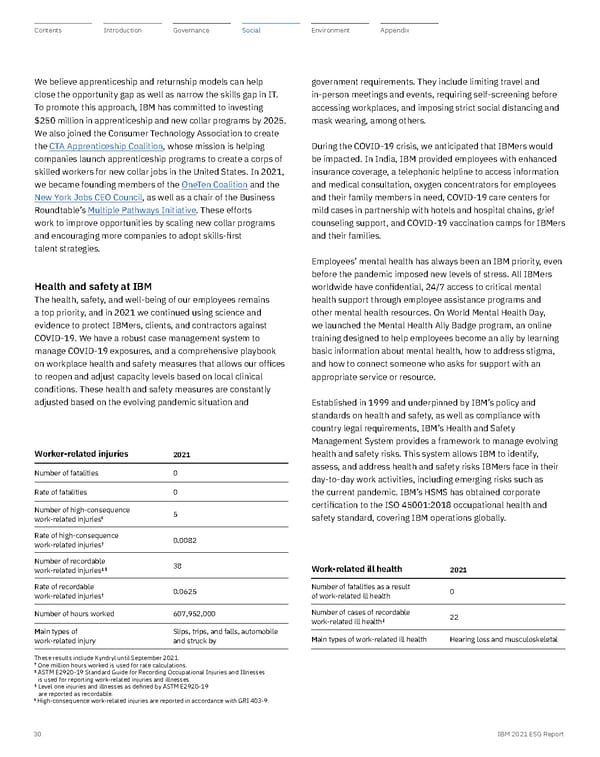We believe apprenticeship and returnship models can help close the opportunity gap as well as narrow the skills gap in IT. To promote this approach, IBM has committed to investing $250 million in apprenticeship and new collar programs by 2025. We also joined the Consumer Technology Association to create the CTA Apprenticeship Coalition , whose mission is helping companies launch apprenticeship programs to create a corps of skilled workers for new collar jobs in the United States. In 2021, we became founding members of the OneTen Coalition and the New York Jobs CEO Council , as well as a chair of the Business Roundtable’s Multiple Pathways Initiative . These efforts work to improve opportunities by scaling new collar programs and encouraging more companies to adopt skills-first talent strategies. Health and safety at IBM The health, safety, and well-being of our employees remains a top priority, and in 2021 we continued using science and evidence to protect IBMers, clients, and contractors against COVID-19. We have a robust case management system to manage COVID-19 exposures, and a comprehensive playbook on workplace health and safety measures that allows our offices to reopen and adjust capacity levels based on local clinical conditions. These health and safety measures are constantly adjusted based on the evolving pandemic situation and government requirements. They include limiting travel and in-person meetings and events, requiring self-screening before accessing workplaces, and imposing strict social distancing and mask wearing, among others. During the COVID-19 crisis, we anticipated that IBMers would be impacted. In India, IBM provided employees with enhanced insurance coverage, a telephonic helpline to access information and medical consultation, oxygen concentrators for employees and their family members in need, COVID-19 care centers for mild cases in partnership with hotels and hospital chains, grief counseling support, and COVID-19 vaccination camps for IBMers and their families. Employees’ mental health has always been an IBM priority, even before the pandemic imposed new levels of stress. All IBMers worldwide have confidential, 24/7 access to critical mental health support through employee assistance programs and other mental health resources. On World Mental Health Day, we launched the Mental Health Ally Badge program, an online training designed to help employees become an ally by learning basic information about mental health, how to address stigma, and how to connect someone who asks for support with an appropriate service or resource. Established in 1999 and underpinned by IBM’s policy and standards on health and safety, as well as compliance with country legal requirements, IBM’s Health and Safety Management System provides a framework to manage evolving health and safety risks. This system allows IBM to identify, assess, and address health and safety risks IBMers face in their day-to-day work activities, including emerging risks such as the current pandemic. IBM’s HSMS has obtained corporate certification to the ISO 45001:2018 occupational health and safety standard, covering IBM operations globally. Worker-related injuries 2021 Number of fatalities 0 Rate of fatalities 0 Number of high-consequence work-related injuries ‖ 5 Rate of high-consequence work-related injuries † 0.0082 Number of recordable work-related injuries ‡,§ 38 Rate of recordable work-related injuries † 0.0625 Number of hours worked 607,952,000 Main types of work-related injury Slips, trips, and falls, automobile and struck by These results include Kyndryl until September 2021. † One million hours worked is used for rate calculations. ‡ ASTM E2920-19 Standard Guide for Recording Occupational Injuries and Illnesses is used for reporting work-related injuries and illnesses. § Level one injuries and illnesses as defined by ASTM E2920-19 are reported as recordable. ‖ High-consequence work-related injuries are reported in accordance with GRI 403-9. Work-related ill health 2021 Number of fatalities as a result of work-related ill health 0 Number of cases of recordable work-related ill health ‡ 22 Main types of work-related ill health Hearing loss and musculoskeletal 30 IBM 2021 ESG Report
 ESG Report | IBM Page 29 Page 31
ESG Report | IBM Page 29 Page 31